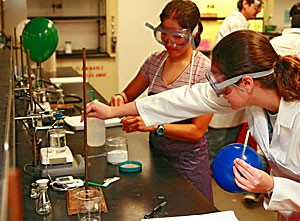A five-year, $3.3 million federal grant given to the UA from the National Science Foundation will be used to bring in top women researchers in science and engineering in an effort to correct gender disparities among faculty.
UA officials believe the grant will have an immediate impact on the university’s goal to increase the number of women and the representation of women faculty in science and engineering.
“”This is a very exciting grant for us to have, as it provides the resources for us to focus on making our campus a place that is welcoming of women scientists and engineers, in addition to helping them reach their full potential as faculty members,”” said Leslie Tolbert, vice president for research.
Women faculty, especially in science, technology, engineering and math, encounter subtle discrimination at many times in their careers, such as feeling less welcome than their male counterparts and lagging behind in salaries and promotions, Tolbert said.
The work funded by the new grant aims to eradicate the discrimination at the UA by increasing the number of female faculty who educate, do research and hold leadership roles.
Experts say that in order for the U.S. to remain competitive, more scientists are needed, and women must be encouraged to complete graduate studies, especially in science, Tolbert added.
The tenure-track faculty in science-related departments at the UA range from 0 percent to 40 percent female. The number of tenure-
It will ultimately improve the reputation of the university as an equitable institution.
– Lisa Elfring,
senior lecturer in biochemistry
track women from underrepresented groups, such as Hispanics and blacks in science departments, is about 1.6 percent, Tolbert said.
Fewer women are granted tenure than men, and women on average continue to earn less than their male counterparts, although the UA has been actively addressing this problem in recent years, Tolbert said.
In the biological sciences, the UA does well in recruiting women into careers in science, said Lisa Elfring, a senior lecturer in biochemistry.
“”But the realities of the academic environment, at least in science, tend to push some women out of the academy once they are partially or all the way through their training,”” Elfring said.
As women proceed along the science training trajectory, they tend to fall out more at each successive step, Elfring said.
“”Part of that is that a devotion to science is difficult, but not impossible, to integrate with a role as a primary caretaker in the family,”” Elfring said.
Bethzaida Astorga, a research graduate assistant in physiological sciences, said she experiences firsthand the
discrepancies between males and females in science education.
“”When I first started, I never considered the gender bias in science, but as I have advanced in my career, it has become very apparent,”” Astorga said. “”This, however, has not really hindered my motivation, because I am truly dedicated to my research and to the contribution that I may be able to make one day.””
Although Astorga said it is frustrating to think about the income discrepancies between genders, it does not change her feelings about research and science.
The UA will be used as a springboard for studies of gender equity, and money from the grant will be used in three specific interventions, which will be assessed for their effectiveness in promoting the success of women in science, Tolbert said.
The first area will focus on cultivating the careers of the women faculty themselves.
This will include a distinguished lecture series, gatherings for sharing of scientific information and mentoring of junior women faculty, Tolbert said.
The second area will focus on how decisions are made by faculty and administrators, with an emphasis on instilling a sense of responsibility for being open-minded and not exclusionary.
“”Committees that select new faculty members and review faculty
performance will be taught how to detect and eliminate discrimination, as well as learning ways to ensure that women faculty are treated fairly,”” Tolbert said.
The third primary area will seek to replace long-standing management practices with new ones designed to cultivate new values and attitudes.
For example, software is being developed that will allow deans and department heads to assess the impact of their decisions on gender equity, Tolbert said.
It is expected that this software will be used for all personnel decisions relating to faculty, Tolbert said.
“”It will ultimately improve the reputation of the university as an equitable institution,”” Elfring said.
In addition to women faculty, students will also reap benefits from the federal grant.
Increasing the diversity of women faculty will have an impact on students in that more diverse perspectives will be presented to them, Tolbert said.
“”They will have a set of teachers, advisers and role models that more accurately reflect the general population,”” she said.
Students have the right to learn science from faculty members who are well-acquainted with the equity issues that they will face as they continue their studies in science, Elfring said.
Astorga believes that nothing should inhibit women who want to pursue a career in science.
“”Don’t let anything stand in the way of what you truly want to do with your life,”” Astorga said. “”There are no careers that do not involve challenges, and a gender bias should not deter anyone from doing what they love.””









